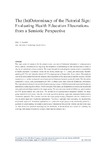The (In)Determinacy of the Pictorial Sign: Evaluating Health Education Illustrations from a Semiotic Perspective

Ver/
Use este enlace para citar
http://hdl.handle.net/2183/13432Coleccións
Metadatos
Mostrar o rexistro completo do ítemTítulo
The (In)Determinacy of the Pictorial Sign: Evaluating Health Education Illustrations from a Semiotic PerspectiveAutor(es)
Data
2012Cita bibliográfica
Culture of communication / Communication of culture, 2012: 1419-1425. ISBN: 978-84-9749-522-6
Resumo
[Abstract] The basic point of departure for the present study was one of Habermas' principles of communicative ethics, namely universalization, requiring the acceptance (Zustimmung) of the communicative norms at play by all concerned without coercion. The study focused on evaluating the communicative acceptability of health education illustrations meant for an elderly (mean age 71.7 years), pre-dominantly Sesothospeaking (84.7%) and primarily female (87.1%) target group in Sharpeville, South Africa. The emphasis was on the relationship between the semiotic other (members of the target group) and the semiotic self (the researcher), i.e. on the contractual axis of semiosis in Johansen's 'semiotic pyramid' model. The first phase comprised a survey with questionnaires (n=140) to obtain input about pictorial illustration preferences. The respondents indicated their preferred option among a range of different pictorial signs and illustration approaches, explaining their choice. On the strength of this input, an illustrated nutrition education calendar was produced and disseminated in the target group. The second phase involved follow-up questionnaires (n=137) approximately one year later. The second set of questionnaires measured whether the target group wanted to move away from the previously agreed on pictorial signs and consensus-based pictorial illustration approach. The outcome was that the target group strongly disagreed with the introduction of new pictorial signs and illustration approaches. This result highlights that evaluating the acceptability of pictorial signs and illustration approaches in a particular target group is not necessarily primarily a question of understanding the complex and tenuous relationship between the referent and the iconic sign, but also about how pictorial meaning may be stabilized, or de-stabilized, as a result of a shifting and evolving relationship between the semiotic other and the semiotic self.
ISBN
978-84-9749-522-6





